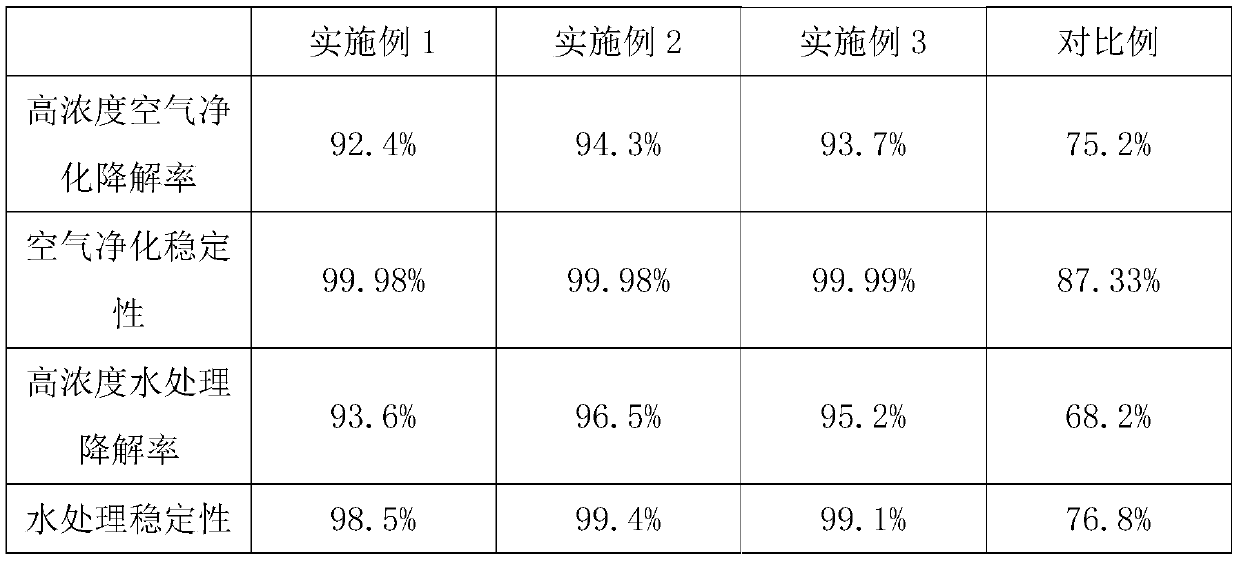Preparation method of efficient titanium-based photocatalyst
A photocatalyst, titanium-based technology, applied in the field of photocatalysis, can solve the problem of low electron yield of nano-titanium dioxide, and achieve the effect of improving photocatalytic efficiency and activity
- Summary
- Abstract
- Description
- Claims
- Application Information
AI Technical Summary
Problems solved by technology
Method used
Image
Examples
Embodiment 1
[0021] A preparation method of high-efficiency titanium-based photocatalyst, comprising the steps of:
[0022] Step 1, put the base material into distilled water and absolute ethanol in order to ultrasonically clean it for 20 minutes, and dry it to obtain a clean base material;
[0023] Step 2, adding polyvinyl alcohol into distilled water and stirring evenly to obtain a polyvinyl alcohol liquid, then immersing the base material in the polyvinyl alcohol liquid, taking it out and drying to obtain a polyvinyl alcohol film;
[0024] Step 3, spraying the nano-titanium monoxide powder on the surface of the polyvinyl alcohol film, and then spraying n-butyl titanate on the surface to obtain a multi-film substrate;
[0025] Step 4, put the multi-film substrate into a sintering kettle, seal and sinter for 2 hours to obtain a titanium-based photocatalytic film.
[0026] The ultrasonic cleaning frequency in step 1 is 50 kHz, the temperature is 40° C., and the drying temperature is 100° ...
Embodiment 2
[0032] A preparation method of high-efficiency titanium-based photocatalyst, comprising the steps of:
[0033] Step 1, put the base material into distilled water and absolute ethanol in order to ultrasonically clean it for 30 minutes, and then dry it to obtain a clean base material;
[0034] Step 2, adding polyvinyl alcohol into distilled water and stirring evenly to obtain a polyvinyl alcohol liquid, then immersing the base material in the polyvinyl alcohol liquid, taking it out and drying to obtain a polyvinyl alcohol film;
[0035] Step 3, spraying the nano-titanium monoxide powder on the surface of the polyvinyl alcohol film, and then spraying n-butyl titanate on the surface to obtain a multi-film substrate;
[0036] Step 4, put the multi-film substrate into a sintering kettle, seal and sinter for 5 hours to obtain a titanium-based photocatalytic film.
[0037] The ultrasonic cleaning frequency in step 1 is 80 kHz, the temperature is 50° C., and the drying temperature is ...
Embodiment 3
[0043] A preparation method of high-efficiency titanium-based photocatalyst, comprising the steps of:
[0044] Step 1, put the base material into distilled water and absolute ethanol in order to ultrasonically clean it for 25 minutes, and dry to obtain a clean base material;
[0045] Step 2, adding polyvinyl alcohol into distilled water and stirring evenly to obtain a polyvinyl alcohol liquid, then immersing the base material in the polyvinyl alcohol liquid, taking it out and drying to obtain a polyvinyl alcohol film;
[0046] Step 3, spraying the nano-titanium monoxide powder on the surface of the polyvinyl alcohol film, and then spraying n-butyl titanate on the surface to obtain a multi-film substrate;
[0047] Step 4, put the multi-film substrate into a sintering kettle, seal and sinter for 4 hours to obtain a titanium-based photocatalytic film.
[0048] The ultrasonic cleaning frequency in step 1 is 70 kHz, the temperature is 45° C., and the drying temperature is 110° C. ...
PUM
 Login to View More
Login to View More Abstract
Description
Claims
Application Information
 Login to View More
Login to View More - R&D
- Intellectual Property
- Life Sciences
- Materials
- Tech Scout
- Unparalleled Data Quality
- Higher Quality Content
- 60% Fewer Hallucinations
Browse by: Latest US Patents, China's latest patents, Technical Efficacy Thesaurus, Application Domain, Technology Topic, Popular Technical Reports.
© 2025 PatSnap. All rights reserved.Legal|Privacy policy|Modern Slavery Act Transparency Statement|Sitemap|About US| Contact US: help@patsnap.com

